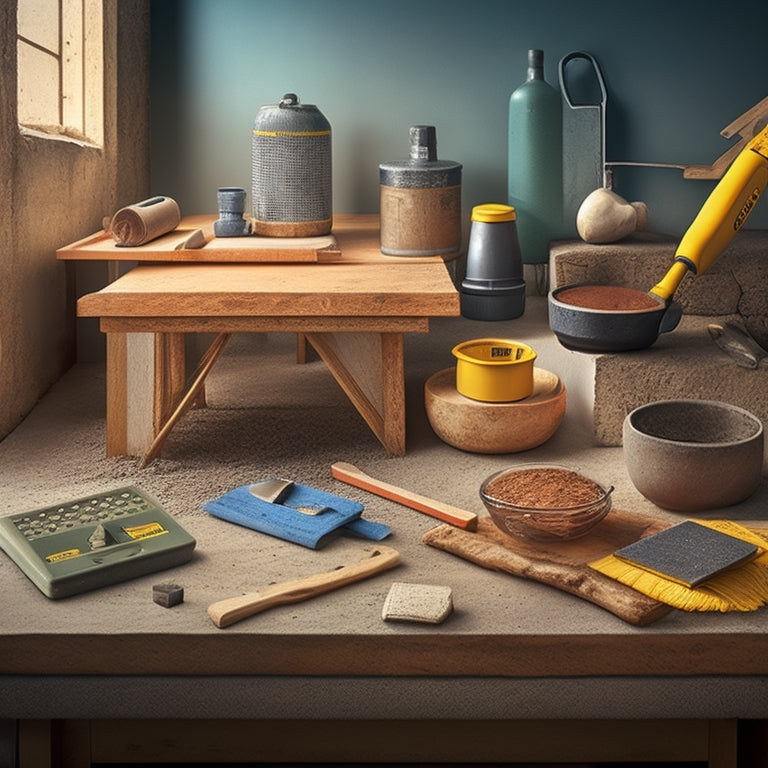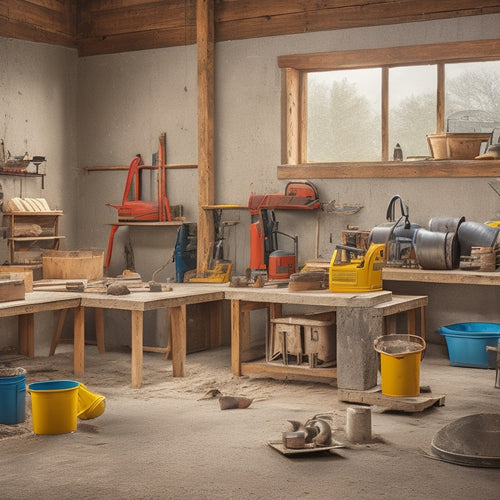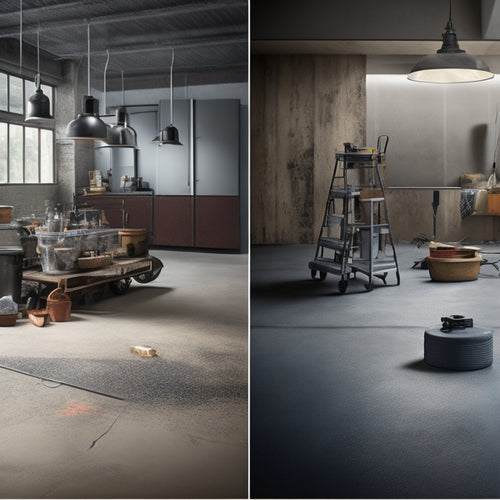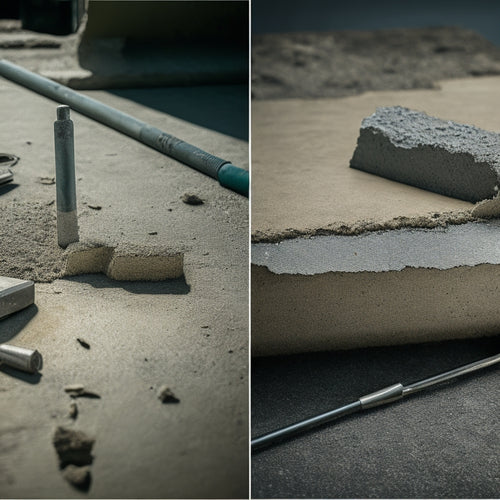
7 Tools You Need for Laying Concrete Blocks
Share
When laying concrete blocks, you'll need seven essential tools to guarantee a solid foundation and accurate placement. Start with a tamping tool for leveling, which compacts soil and eliminates air pockets. A spirit level ensures accurate leveling and plumbness. A rubber mallet taps blocks into place without causing damage. A joint spade is necessary for cleaning excess mortar from joints. A block lifter simplifies handling and placement of heavy blocks. Line and pins establish precise alignment, and safety gloves protect your hands from abrasion and punctures. With these tools, you'll be well on your way to a successful project, and mastering their uses will take your skills to the next level.
Key Takeaways
- A tamping tool is essential for compacting soil and eliminating air pockets beneath concrete blocks to ensure a solid foundation.
- A spirit level guarantees accurate leveling of the ground and checks plumb and deviations from the desired plane for structural integrity.
- A rubber mallet is necessary for tapping concrete blocks into place without causing damage, aligning block edges, and ensuring proper spacing.
- A block lifter simplifies handling and placement of heavy concrete blocks, reducing fatigue and increasing efficiency during block projects.
- Safety gloves with abrasion and puncture resistance are required to protect hands from injury and prevent project delays.
Tamping Tool for Leveling
When you're laying concrete blocks, ensuring they're properly leveled is essential, as even slight deviations can lead to structural issues down the line. To achieve this, you'll need to compact the soil and eliminate any air pockets beneath the blocks. This is where a tamping tool comes in. A tamping tool is used to compact and level the soil, ensuring a solid foundation for your concrete blocks.
Mastering tamping techniques is vital, as improper compaction can lead to settling or shifting of the blocks over time. Start by using the tamping tool to compact the soil in sections, working in small areas to maintain even pressure.
Apply gentle to moderate pressure, depending on the soil type and moisture content. As you tamp, check the soil's density by inserting a rod or screwdriver; if it slides in easily, the soil is compacted. Repeat this process until the entire area is compacted and level.
Spirit Level for Accuracy
You'll use a spirit level to guarantee your concrete block laying is accurate by leveling the ground precisely, guaranteeing perfect plumb, and checking for any deviations from the desired plane.
This tool is essential for achieving a level foundation, which is critical for the structural integrity of the final structure.
Leveling the Ground
Accurate ground leveling is vital for a solid concrete block foundation, as uneven terrain can lead to structural instability and water accumulation issues.
You'll need to verify the ground is level, compact, and even before laying the first block. Start by clearing the area of debris, vegetation, and obstructions.
Next, conduct a thorough ground preparation by grading the soil to create a uniform surface. This step is significant, as it will prevent settlement and cracking of the concrete blocks.
Use a spirit level to check the ground's accuracy and make adjustments as needed. You may need to add or remove soil to achieve the desired level.
Once you've achieved a level surface, it's time for soil compaction. This can be done using a hand tamper, plate compactor, or a heavy roller, depending on the size of your project.
Proper soil compaction will prevent settling and guarantee a solid base for your concrete blocks. Take your time during this process, as it's vital for the integrity of your structure.
With a level and compacted ground, you'll be ready to move on to the next step in laying your concrete blocks.
Ensure Perfect Plumb
With the ground leveled and compacted, it's vital to guarantee perfect plumb to prevent deviations in the block layout.
You'll need a reliable spirit level to ascertain accurate vertical alignment. This tool allows you to check the block's orientation, confirming it's perfectly plumb and level. A plumb bob can also be used to double-check your work, providing an added layer of accuracy.
When using a spirit level, place it on top of the block or on a straightedge spanning multiple blocks. The level's vial will indicate if the block is plumb or not.
Make adjustments as needed until the vial's bubble is centered, indicating perfect plumb. This process is important, as even slight deviations can lead to significant errors down the line.
Checking for Deviations
Every block laid must be meticulously checked for deviations from perfect plumb. You can't afford to ignore even the slightest variation, as it can compromise the structural integrity of the entire wall.
To guarantee accuracy, you'll need to employ a range of measuring tools to conduct deviation analysis.
- Use a spirit level to verify the block's position, checking for any deviation from the vertical or horizontal plane.
- Employ a straightedge or string line to detect any deviation from the desired course or line.
- Utilize a laser level to project a precise level or plumb line, allowing you to check for deviations with ease.
- Take precise measurements with a tape measure or ruler to identify any deviations in block spacing or alignment.
- Perform regular checks with a digital inclinometer to verify the block's angle and guarantee it remains within the specified tolerance.
Rubber Mallet for Tapping
You'll use a rubber mallet to tap each concrete block into place, ensuring it's properly seated on the mortar.
As you tap, you'll also be aligning the block's edges with the adjacent blocks, creating a level and plumb structure.
Tapping Block Into Place
Tapping a block into place requires finesse and the right tool. A rubber mallet is essential for tapping blocks into position without damaging them. When you're laying concrete blocks, you'll need to tap them gently into place to guarantee proper alignment and even spacing.
Here's how to master the art of tapping blocks into place:
-
Hold the mallet at a 45-degree angle to the block, with the striking surface parallel to the block's surface.
-
Use a gentle, controlled motion to tap the block into position, starting at the center and working your way outward.
-
Apply even pressure to avoid pushing the block out of alignment.
-
Use short, light taps to avoid damaging the block or dislodging adjacent blocks.
-
Check the block's position frequently to verify it's properly seated and aligned.
Aligning Block Edges
With the block securely in place, your focus shifts to confirming its edges align perfectly with adjacent blocks. This critical step in block placement requires precision and attention to detail.
You'll use your rubber mallet to tap the block gently, making minute adjustments to achieve perfect alignment.
Begin by checking the edge measurement of the block against the adjacent blocks. Hold a level against the block's edge to confirm it's plumb and level. If necessary, use your trowel to add or remove excess mortar, making adjustments to the block's position.
Using your rubber mallet, tap the block gently on its edge, using a gentle, glancing blow. This helps to nudge the block into perfect alignment without dislodging it from its bed of mortar.
Continue to check the edge measurement and make adjustments as needed until the block's edges are perfectly flush with the surrounding blocks.
Joint Spade for Cleaning
A joint spade is a specialized tool designed specifically for cleaning excess mortar from between concrete blocks, ensuring a clean, professional-looking finish.
You'll use it to maintain clean joints, which is essential for joint maintenance and the overall structural integrity of your concrete block structure.
When using a joint spade, follow these cleaning techniques to get the best results:
- Hold the spade at a 45-degree angle to the joint and gently scrape out excess mortar.
- Use a gentle pushing motion to avoid damaging the blocks or dislodging the mortar.
- Clean the spade regularly to prevent mortar from building up and making the tool less effective.
- Use the joint spade in conjunction with a stiff-bristled brush to remove any remaining debris or dust.
- For particularly stubborn mortar, use a gentle tapping motion to dislodge it without applying too much pressure.
Block Lifter for Easy Handling
Lift concrete blocks with ease using a block lifter, a specialized tool designed to simplify the handling and placement of heavy blocks. As you work on your concrete block project, you'll appreciate the efficiency and reduced fatigue that comes with using a block lifter.
There are several types of block lifters available, including vacuum lifters, mechanical grab lifters, and chain lifters, each suited for specific block sizes and weights.
Choose the right block lifter for your project, and master the block handling techniques that guarantee accurate placement and alignment. When using a block lifter, make sure to position it correctly under the block, taking care not to damage the block's edges or corners.
Lift the block slowly and steadily, keeping it level and stable as you move it into place. By following these block handling techniques and using the right block lifter, you'll be able to work more efficiently and effectively, producing high-quality results with minimal effort.
Line and Pins for Alignment
As you prepare to lay concrete blocks, establishing a precise alignment is vital to guarantee a sturdy and even structure. To achieve this, you'll need a line and pins for alignment. These tools enable you to mark the course of your blocklaying, making certain that your blocks are laid straight and level.
When it comes to alignment techniques, marking methods are significant. You'll need to create a reference line to guide your blocklaying.
Here's what you'll need:
- A string line or nylon cord to serve as your reference line
- Pins or clips to secure the line to the ground or a fixed point
- A spirit level to verify the line is level and plumb
- A marker or chalk to mark the position of each block on the line
- A story pole or vertical reference point to check the alignment of each course
Safety Gloves for Protection
Two essential pairs of safety gloves are a must-have in your concrete blocklaying toolkit.
You'll need one pair for mixing and handling concrete, and another for laying blocks to prevent cross-contamination. When selecting gloves, prioritize hand protection by choosing materials that provide superior abrasion resistance, puncture resistance, and grip.
Look for gloves made from high-quality materials like goatskin, cowhide, or synthetic fabrics that mimic the durability of leather. These materials will protect your hands from cuts, abrasions, and punctures caused by rough concrete blocks, sharp edges, and tools.
Additionally, consider gloves with a textured palm and fingertips for improved grip on slippery surfaces. Don't compromise on hand protection – a single injury can set your project back considerably.
Invest in two reliable pairs of safety gloves to guarantee you can work efficiently and safely throughout the project.
Frequently Asked Questions
How Do I Prevent Concrete Blocks From Shifting During Construction?
To prevent concrete blocks from shifting during construction, you'll guarantee precise block alignment by using a level and string lines, and implement stability measures like temporary bracing and adequate mortar coverage to maintain structural integrity.
Can I Reuse Old Mortar Between Blocks?
You shouldn't reuse old mortar between blocks, as it can compromise block adhesion and structural integrity; instead, mix a fresh mortar mixture according to the manufacturer's instructions to guarantee a strong and durable bond.
What Is the Ideal Temperature for Laying Concrete Blocks?
As you carefully craft your concrete canvas, make certain you're working within the sweet spot of 50°F to 70°F, where concrete curing flourishes, unaffected by temperature extremes that can compromise strength and stability.
How Do I Ensure Drainage Behind Concrete Block Walls?
You must guarantee proper drainage behind concrete block walls by implementing effective drainage solutions, such as installing a French drain orweep holes, to maintain wall stability and prevent water accumulation that can lead to structural issues.
Can I Lay Concrete Blocks Directly on the Ground?
You shouldn't lay concrete blocks directly on the ground without proper soil preparation, as it can lead to settlement and structural issues; instead, create a solid concrete block foundation by excavating and compacting the soil, ensuring a stable base.
Conclusion
You've assembled the essential tools for laying concrete blocks, but you might be thinking, "Do I really need all of these?" Yes, you do. Each tool plays a critical role in ensuring accuracy, precision, and safety. Skipping any of these tools can lead to subpar results, wasted materials, or even injuries. By investing in these seven tools, you'll guarantee a professional-grade outcome and avoid costly mistakes.
Related Posts
-

What Tools to Rent for a Concrete Home Reno
When tackling a concrete home renovation, you'll need to rent a variety of specialized tools to get the job done. For...
-

Top Tools for Revamping Old Concrete Floors
You'll need a range of tools to revamp your old concrete floor, starting with epoxy, acrylic, or polyurethane paint, ...
-

Top Tools for Concrete Adhesion Success
When it comes to concrete adhesion success, you'll need to wield the right tools and techniques to guarantee a strong...


